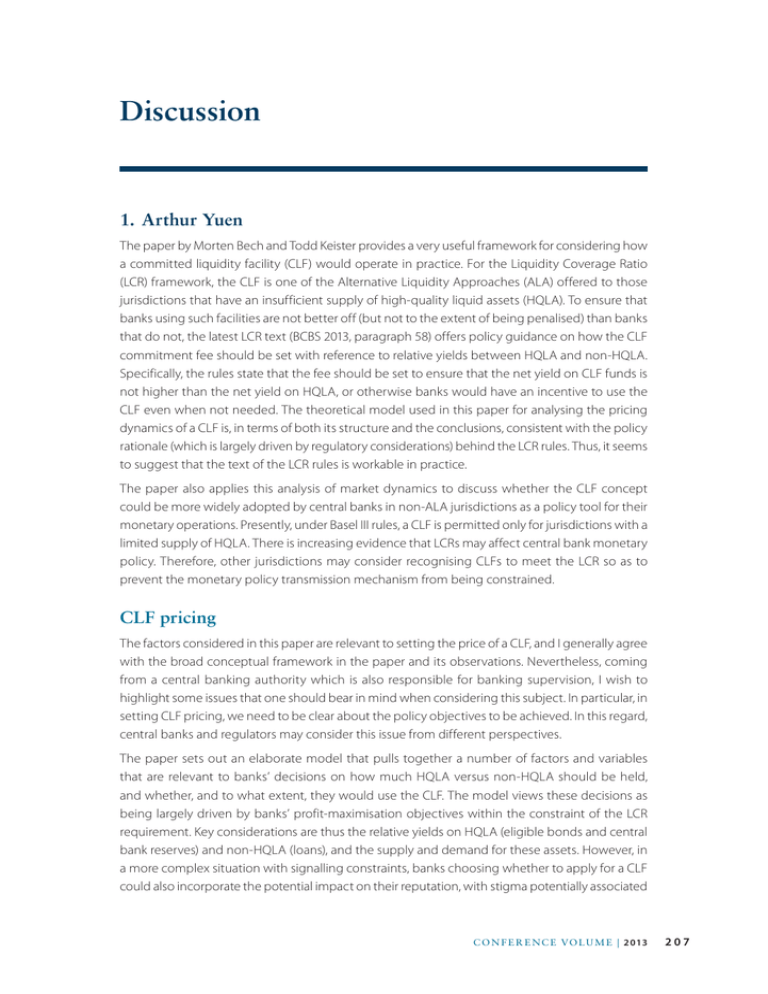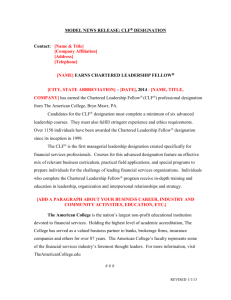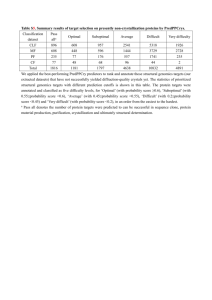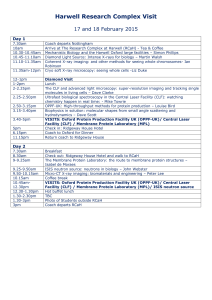Discussion 1. Arthur Yuen
advertisement

Discussion 1. Arthur Yuen The paper by Morten Bech and Todd Keister provides a very useful framework for considering how a committed liquidity facility (CLF) would operate in practice. For the Liquidity Coverage Ratio (LCR) framework, the CLF is one of the Alternative Liquidity Approaches (ALA) offered to those jurisdictions that have an insufficient supply of high-quality liquid assets (HQLA). To ensure that banks using such facilities are not better off (but not to the extent of being penalised) than banks that do not, the latest LCR text (BCBS 2013, paragraph 58) offers policy guidance on how the CLF commitment fee should be set with reference to relative yields between HQLA and non-HQLA. Specifically, the rules state that the fee should be set to ensure that the net yield on CLF funds is not higher than the net yield on HQLA, or otherwise banks would have an incentive to use the CLF even when not needed. The theoretical model used in this paper for analysing the pricing dynamics of a CLF is, in terms of both its structure and the conclusions, consistent with the policy rationale (which is largely driven by regulatory considerations) behind the LCR rules. Thus, it seems to suggest that the text of the LCR rules is workable in practice. The paper also applies this analysis of market dynamics to discuss whether the CLF concept could be more widely adopted by central banks in non-ALA jurisdictions as a policy tool for their monetary operations. Presently, under Basel III rules, a CLF is permitted only for jurisdictions with a limited supply of HQLA. There is increasing evidence that LCRs may affect central bank monetary policy. Therefore, other jurisdictions may consider recognising CLFs to meet the LCR so as to prevent the monetary policy transmission mechanism from being constrained. CLF pricing The factors considered in this paper are relevant to setting the price of a CLF, and I generally agree with the broad conceptual framework in the paper and its observations. Nevertheless, coming from a central banking authority which is also responsible for banking supervision, I wish to highlight some issues that one should bear in mind when considering this subject. In particular, in setting CLF pricing, we need to be clear about the policy objectives to be achieved. In this regard, central banks and regulators may consider this issue from different perspectives. The paper sets out an elaborate model that pulls together a number of factors and variables that are relevant to banks’ decisions on how much HQLA versus non-HQLA should be held, and whether, and to what extent, they would use the CLF. The model views these decisions as being largely driven by banks’ profit-maximisation objectives within the constraint of the LCR requirement. Key considerations are thus the relative yields on HQLA (eligible bonds and central bank reserves) and non-HQLA (loans), and the supply and demand for these assets. However, in a more complex situation with signalling constraints, banks choosing whether to apply for a CLF could also incorporate the potential impact on their reputation, with stigma potentially associated C O N F E R E N C E VO L U M E | 2 013 207 DISC USSION with using a CLF. From the viewpoint of Hong Kong banks, a CLF would not be problematic in positive states of the world, but banks are concerned that during stress periods the market may look on CLF holders with a bias. Ultimately, these non-price factors could substantially affect whether firms use CLFs and the degree to which they use them. In considering optimal pricing of the CLF, it is also important to be clear about the policy objective in mind. Commercial banks, central banks and regulators may each have a different view of the appropriate price of a CLF. For regulators, conservative pricing of the CLF may be preferred so as not to defeat the purpose of the LCR as a tool to ensure banks self-insure against liquidity risk. That is, pricing should discourage commercial banks from relying on central banks for day-to-day liquidity management (a lender of ‘first’, rather than ‘last’ resort). By comparison, for central banks there will generally be a desire to ensure that LCRs do not unnecessarily constrain the control of interest rates and monetary policy transmission. Higher pricing of the CLF would discourage banks from using a CLF when not strictly necessary, but would defeat the purpose of the CLF if prices were so high that no firm chose to use it. Operation of the CLF under the LCR Another important observation of the paper is related to what policymakers may consider when operationalising the CLF under the LCR. The paper suggests that the fee set on the CLF always equalises the yield spread between HQLA and non-HQLA assets. The market dynamics for this result are not difficult to understand: as long as the fee is less than the price premium on HQLA, commercial banks will substitute into the CLF; the demand for HQLA will consequently fall, reducing the yield spread until it equals the cost of the CLF. While this is how the market dynamics should work, paragraph 58 of the LCR rules states that a central bank should price the CLF to preclude any net yield advantage from using the CLF (see BCBS (2013)). From my interpretation, this is an ex ante requirement. Assuming market dynamics ultimately bring the yield spread between HQLA and non-HQLA back to the CLF pricing level in practice, we need to be very careful to oppose any argument that the specific LCR policy objectives outlined in paragraph 58 are met simply by CLF pricing ultimately being equal to the yield spread on an ex post basis. In jurisdictions where the supply of HQLA is not an issue, the yield spread between HQLA and non-HQLA is equally relevant. Moreover, the stigma associated with using the CLF may be more prominent. A commercial bank relying habitually upon these facilities for meeting liquidity requirements sends a particularly negative signal when it is known that there is a sufficient supply of HQLA in the market. The stigma issue could thus become particularly relevant in times of stress, so the design of the CLF would be particularly important in order to avoid this issue. In these non-ALA jurisdictions, there is a strong prudential case to price the CLF in a slightly more penal manner in order to reduce its attractiveness. The incentive for commercial banks to use CLFs strategically in a non-ALA environment is much higher than in an ALA environment; hence more caution is needed in pricing. Regulatory issues and challenges There are other regulatory issues and challenges that affect the operation of a CLF under the LCR. For example: 208 R E S E RV E B A N K O F AU S T R A L I A DISC USSION •• Designing the terms and structure of a CLF appropriately to guard against moral hazard and address stigma issues. •• The need for regulatory constraints on a CLF, for example collateral policy and scope of recognition under the LCR, rather than pricing only. •• The extent of international harmonisation of the CLF structure, noting that full standardisation is impractical but divergence in policy will create level playing field issues. •• Operating a CLF differently in normal and stressed states, which further requires clearly defining such periods. •• The effect of a CLF on the operation of other central bank facilities such as emergency liquidity facilities. This model structure will provide a good starting point for understanding the pricing issue, but the factors above may be equally if not more important decisions for the central bank, especially in a non-ALA environment. It is also important to conduct further studies on whether there are other factors to include in the analysis. Reference BCBS (Basel Committee on Banking Supervision) (2013), Basel III: The Liquidity Coverage Ratio and Liquidity Risk Monitoring Tools, Bank for International Settlements, Basel. 2.General Discussion The paper by Morten Bech and Todd Keister, and Arthur Yuen’s discussion, were both the subject of robust discussion. Central to the discussion were a range of questions exploring how the analysis would be affected by incorporating various additional features into the model. One participant asked how the analysis would change under an interest-on-reserves monetary policy framework, where there was no shortage of reserves to meet the LCR. Dr Keister indicated his personal support for such a system if the central bank could supply reserves by purchasing government bonds, noting that in jurisdictions such as Australia the shortage of HQLA would still bind. A second participant noted that the penalty for breaking the LCR was exogenous in the model, and asked whether this could be treated as another policy instrument. Dr Keister clarified that in the current model the penalty came from the fact that banks were forced to borrow at the discount window to meet the LCR, but that penalty could be separately identified in a more detailed model. Another participant suggested that in practice banks would prefer to hold bonds rather than reserves to meet a HQLA requirement, because bonds could be used for other purposes, including repo. They also noted that bonds generally attracted a premium, and asked if they would attract a higher yield than reserves in the model’s equilibrium. Dr Keister responded that, given the quantity of reserves was set by the central bank, prices would adjust so that banks were indifferent at the margin between holding bonds and reserves. He also agreed that the bond yield would be higher in equilibrium, but noted that the spread would be negligible when banks rely on the central bank to create a large volume of reserves to meet their LCR requirements. Dr Bech concurred, C O N F E R E N C E VO L U M E | 2 013 209 DISC USSION and noted that there would be differences in spreads between bond yields but that this would not affect the core analysis. Another discussion was motivated by the comment that CLFs were not designed to be used as an economic choice for banks. One participant noted that the Australian implementation of the CLF involved a prudential supervisor deciding the amount of CLF funding allocated to banks. Dr Keister responded that in their model, banks made an economic choice to use the cheaper of the CLF and bonds such that marginal costs were equalised, and stated that he did not think the regulations were definitive on this matter. The participant further suggested that the price of the CLF was irrelevant in a jurisdiction with a shortage of HQLA, because a CLF was then only used by banks under compulsion. Dr Keister disagreed about the relevance of pricing, stating that, at the margin, more bonds could move into the banking system, and that CLF pricing could affect other market interest rates in equilibrium, even if quantity movements from substitution were small. The potential for stigma concerns to reduce the use and thus the efficacy of CLFs was explored by several participants. Responding to Mr Yuen’s discussion, Dr Keister agreed that stigma was an important factor not considered in the model, but suggested that the scope for stigma could be mitigated by an appropriately designed auction mechanism. He hypothesised that by auctioning a fixed quantity of CLF, the equilibrium result could not be characterised by all parties staying away due to stigma concerns. The potential for stigma was also considered in a discussion about the appropriate pricing of the CLF. Several participants summarised the CLF as an insurance mechanism for a liquidity crisis, and asked whether its price in the model incorporated the expected cost of the adverse outcome, or varied in accordance with counterparty risk. One participant then noted that invariant pricing could create a substantial adverse selection problem in economies that were not HQLA-constrained and, as a result, accessing the CLF would send a strong negative signal about the bank’s solvency. Separately, Dr Keister responded to a question about how to resolve a situation in which multiple regulators had different views of appropriate pricing, saying that parties would need to agree on a desired equilibrium, and then use the CLF to bring it about. In response to several queries about competition in the provision of liquidity insurance between central banks and, where relevant, the private sector through collateral swaps and rehypothecation, Mr Yuen clarified his previous comments about level playing field issues with the CLF. He stated that without international harmonisation of what collateral was acceptable for CLF purposes, a bank operating in multiple jurisdictions could arrange its operations to take advantage of less stringent rules. He suggested that other differences could also give rise to similarly unearned competitive advantages. The discussion concluded with a debate over why policymakers would prefer banks to manage their own liquidity arrangements, rather than have central banks supply liquidity against illiquid assets. Several participants suggested that reliance on central bank liquidity reduced the incentives for banks to undertake thorough risk management. In particular, it was pointed out that permanently moving bank assets to the central bank’s balance sheet would involve the central bank taking on substantial credit risk and potential losses. Rather, central banks were more comfortable providing liquidity on a contingent basis, where a bank’s solvency could be assessed before choosing whether to provide loan funding. 210 R E S E RV E B A N K O F AU S T R A L I A






